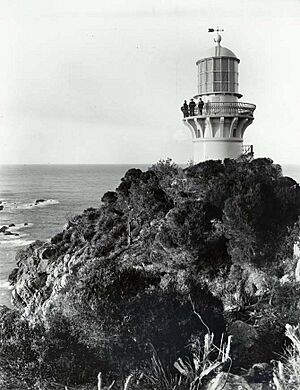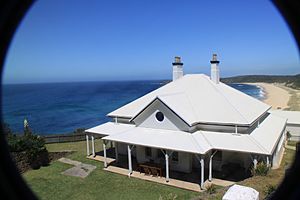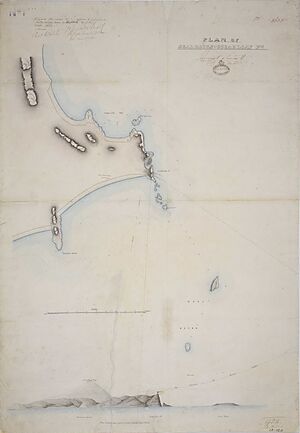Sugarloaf Point Light facts for kids
| Location | Seal Rocks Road, Myall Lakes National Park, Seal Rocks, Mid-Coast Council, New South Wales, Australia |
|---|---|
| Coordinates | 32°26′27″S 152°32′21″E / 32.44083°S 152.53917°E |
| Year first constructed | 1875 |
| Automated | 1987 |
| Construction | Rendered brick tower |
| Tower shape | Cylindrical tower with balcony and lantern, external spiral stairway |
| Markings / pattern | White tower and lantern, black balcony rail |
| Height | 49 feet (15 m) |
| Focal height |
|
| Original lens | 1st order Chance Brothers Fresnel lens |
| Intensity | 780,000 cd |
| Range |
|
| Characteristic |
|
The Sugarloaf Point Light, also known as Seal Rocks Lighthouse, is an active lighthouse in New South Wales, Australia. It stands on Sugarloaf Point, about 3 kilometres (1.9 miles) southeast of Seal Rocks. This lighthouse helps guide ships safely past the dangerous rock formations nearby.
It was the first lighthouse designed by James Barnet, a famous architect. John McLeod built it between 1874 and 1875. It is one of only two lighthouses in Australia with an outside stairway. The lighthouse is part of the Myall Lakes National Park and is owned by the National Parks and Wildlife Service. It is listed on the Commonwealth Heritage List and the New South Wales State Heritage Register.
The Australian Maritime Safety Authority operates the light. The buildings are looked after by the Land and Property Management Authority. You can drive to the lighthouse, but the tower itself is not open to visitors. However, a nearby lookout offers great views.
Contents
History of the Lighthouse
Early Days and the Worimi People
The land around Seal Rocks and Myall Lakes traditionally belongs to the Worimi people. Their territory stretched from Maitland in the south to Forster in the north. The Worimi people lived by hunting and gathering, using the ocean's resources for food. Many places in the area are important to their culture and beliefs.
In the early 1800s, Europeans began exploring the Myall Lakes region. As more ships traveled along the coast, the rocky areas near Sugarloaf Point became very dangerous. Many ships were at risk. By the mid-1800s, people realized that more lighthouses were needed along the New South Wales coastline.
Planning the Lighthouse
In 1863, a group of experts suggested building a lighthouse at Seal Rocks. They saw that shipping traffic was growing fast. They wanted to make the coast safer for ships.
It took about 10 years to decide the best spot for the lighthouse. Building it directly on the Seal Rocks was too difficult because of access problems. So, in 1873, Sugarloaf Point was chosen. James Barnet, the Colonial Architect, and Captain Francis Hixson of the Marine Board agreed on this location. Captain Hixson famously said he wanted the NSW coast "illuminated like a street with lamps." By the early 1900s, his vision came true, with many lighthouses built along the coast.
Building the Lighthouse
Once the location was set, Barnet drew up the plans. John McLeod was chosen to build it in April 1874. To get materials to the site, workers built a 457-meter (1,500 ft) long jetty. This jetty helped land 1,800 tonnes (2,000 short tons) of supplies.
The lighthouse was finished in 1875, and its light shone for the first time on December 1, 1875. A road was also built to Bungwahl, which helped that town grow. A camp for the construction workers was set up, with barracks, offices, a kitchen, and even a school.
The lighthouse tower is 15 meters (49 ft) tall. It has a curved balcony and a domed oil storage area. These features became typical of Barnet's designs. The lighthouse also had other buildings, like cottages for the Head Keeper and Assistant Keepers, a signal house, and a paint store. These buildings were placed on the southern side of the headland to protect them from harsh weather.
How the Light Worked
The lighthouse was ready in just 18 months. On December 1, 1875, the light was turned on. It used a special lens from England called a 1st Order sixteen-panel Fresnel lens. This lens is still there today.
The original light source was a kerosene lamp. It was upgraded in 1923 to a carbide lamp. In June 1966, the light was changed to electricity, making it much brighter.
The lighthouse became automated in 1987, meaning it could run without people constantly there. A caretaker stayed on site until 2006–2007. Today, the old keeper's residences are used for tourist accommodation.
The current light uses a powerful lamp and is powered by electricity, with a backup generator. It flashes white every 7.5 seconds. There's also a red light that shines towards Seal Rocks to warn ships of dangers. This red light was originally green but was changed in the 1980s.
The Sugarloaf Point Lightstation has changed over time with new technology. Its original sixteen-sided lens is still working, making it unique in Australia. The station slowly had fewer staff. From three keepers, it went down to two in 1966. After automation in 1987, keepers were no longer needed. Now, it's a popular place for tourists.
About the Lighthouse Buildings
The Sugarloaf Point Lightstation is located inside the Myall Lakes National Park. It sits on a headland that stands out naturally. The site includes the lighthouse and several other buildings. These include cottages for the Head Keeper and Assistant Keepers, a Signal House, a Paint Store, and a Generator Building.
The lighthouse tower is 15 meters (49 ft) tall. It still has its original lantern from Chance Bros. The tower has two levels, with an outside stairway made of bluestone leading to the first floor. From there, iron steps go up to the lantern room. Around the top of the tower is a curved balustrade and handrail. These features, along with the domed oil store and upper balcony, show James Barnet's unique architectural style.
The lighthouse is made of bricks covered in cement and painted white. The ground floor was used to store fuel. A brick path surrounds the base of the tower, enclosed by a 1.2-meter (4 ft) high white brick wall.
The other buildings at the lightstation are simple but well-designed. They are all made of blue and white painted brickwork and are in very good condition. They were built on the southern side of the headland to be protected from the weather. The original Head Keeper's cottage and two Assistant Keepers' cottages were designed by Barnet in 1875. These cottages were updated in 2006 and are now used for holiday stays.
North of the tower is a flag semaphore signal station. There's also an old concrete base for a flagstaff. Other buildings include a generator shed, a workshop, a paint store, and a garage.
Condition and Changes
The lighthouse and its buildings are kept in very good condition. This is because the site is still used as a lighthouse and a tourist spot. Caretakers live on site and help with daily maintenance.
Even though some parts like kitchens and bathrooms have been updated for modern use, the original design of the main buildings is still clear. The lightstation has been well-preserved, showing its long history.
Over the years, the lighthouse has been updated with new technology. The light source changed from oil to kerosene in 1911, and then to electricity in 1966. The auxiliary light, which shines over Seal Rocks, was changed from green to red in 1984. The station became fully automated in 1987.
The residential buildings have also had minor changes, mainly updating their facilities. In 2006, the National Parks and Wildlife Service did important repair work to keep the buildings strong and safe.
Heritage Importance
The Sugarloaf Point Lightstation Group is very important to the history of New South Wales. It was built in 1875 and was the first major lighthouse in the "highway of lights" system. This system of lighthouses was built along the NSW coast in the late 1800s to make shipping safer.
The lightstation is also important because of its connection to James Barnet, the Colonial Architect, and Captain Francis Hixson. Barnet designed many lighthouses, and Sugarloaf Point was his first major one. It shows many of his unique design features, like the domed oil store and curved balcony railings. The external staircase on this lighthouse is a rare feature for Barnet's designs.
The site also has historical value from its construction and early operation. There are even archaeological remains from the construction camp that existed only during 1874-1875. The area also holds importance for the Worimi people, with evidence of their ancient campsites and middens.
The Sugarloaf Point Lightstation is a great example of the lighthouses built in New South Wales during that time. Its design and compact layout show how typical regional lightstation complexes were built across Australia.
See also




